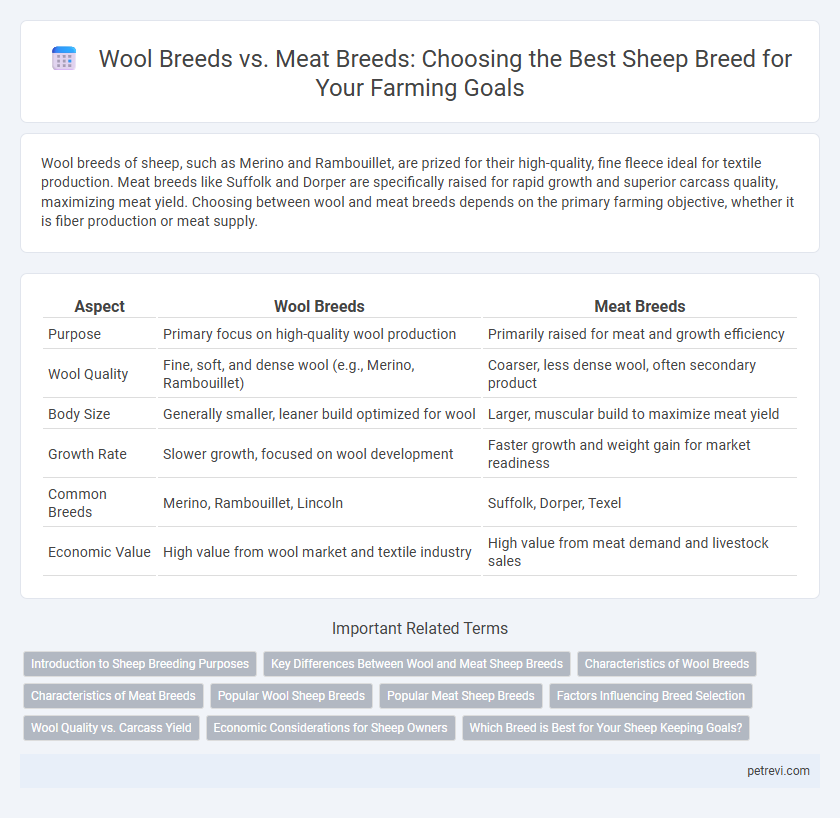Wool breeds of sheep, such as Merino and Rambouillet, are prized for their high-quality, fine fleece ideal for textile production. Meat breeds like Suffolk and Dorper are specifically raised for rapid growth and superior carcass quality, maximizing meat yield. Choosing between wool and meat breeds depends on the primary farming objective, whether it is fiber production or meat supply.
Table of Comparison
| Aspect | Wool Breeds | Meat Breeds |
|---|---|---|
| Purpose | Primary focus on high-quality wool production | Primarily raised for meat and growth efficiency |
| Wool Quality | Fine, soft, and dense wool (e.g., Merino, Rambouillet) | Coarser, less dense wool, often secondary product |
| Body Size | Generally smaller, leaner build optimized for wool | Larger, muscular build to maximize meat yield |
| Growth Rate | Slower growth, focused on wool development | Faster growth and weight gain for market readiness |
| Common Breeds | Merino, Rambouillet, Lincoln | Suffolk, Dorper, Texel |
| Economic Value | High value from wool market and textile industry | High value from meat demand and livestock sales |
Introduction to Sheep Breeding Purposes
Sheep breeding primarily targets two main purposes: wool production and meat yield, each with distinct breed characteristics. Wool breeds, such as Merino and Rambouillet, are valued for their high-quality, fine fleece ideal for textile industries, while meat breeds like Suffolk and Dorper emphasize rapid growth rates and carcass quality. Selecting the appropriate breed depends on the intended market demand, environmental adaptation, and economic goals of sheep farming operations.
Key Differences Between Wool and Meat Sheep Breeds
Wool breeds like Merino are primarily valued for their high-quality fleece, producing fine, dense wool ideal for textile manufacturing, whereas meat breeds such as Suffolk are bred for rapid growth, muscular build, and efficient feed conversion to maximize lamb meat yield. Wool breeds tend to have finer, softer fibers with higher fleece weight, while meat breeds prioritize traits like larger frame size and carcass quality over fleece characteristics. Understanding these key differences aids farmers in selecting sheep according to production goals, whether focusing on premium wool output or optimized meat production.
Characteristics of Wool Breeds
Wool breeds of sheep, such as Merino and Rambouillet, are specifically cultivated for their fine, soft, and dense fleece, which is highly valued in textile production. These breeds typically possess high-quality wool fibers with superior crimp and elasticity, making them ideal for producing garments and fabrics. Unlike meat breeds, wool breeds often have slower growth rates and leaner body conformation, emphasizing fiber yield and quality over meat production.
Characteristics of Meat Breeds
Meat breeds of sheep, such as Suffolk, Hampshire, and Texel, are specifically bred for rapid growth, high muscle yield, and superior carcass quality, making them ideal for meat production. These breeds exhibit robust body conformation with well-developed muscling, high feed conversion efficiency, and favorable meat-to-bone ratios, distinguishing them from wool breeds that prioritize fleece characteristics. Their genetic traits focus on lean meat, tenderness, and substantial weight gain, optimizing profitability in commercial lamb production.
Popular Wool Sheep Breeds
Merino, Romney, and Rambouillet stand out among popular wool sheep breeds known for their fine, soft fleece ideal for textile production. These wool breeds produce high-quality fibers with excellent crimp and length, making them valuable for crafting garments and industrial textiles. In contrast, meat breeds like Suffolk and Dorper prioritize muscle development and growth rates over fleece quality, emphasizing their role in meat production rather than wool yield.
Popular Meat Sheep Breeds
Popular meat sheep breeds like the Suffolk, Dorper, and Texel are valued for their rapid growth rates, high-quality lean meat, and efficient feed conversion. These breeds exhibit muscular builds and produce carcasses with favorable meat-to-bone ratios, making them ideal for commercial meat production. Unlike wool breeds such as Merino, meat breeds prioritize muscle development and meat yield over fine wool quality.
Factors Influencing Breed Selection
Wool breeds such as Merino produce high-quality, dense fleece ideal for textile industries, while meat breeds like Dorset are optimized for rapid growth and muscle yield. Factors influencing breed selection include climate adaptability, feed availability, and economic goals, which determine whether fiber production or meat output is prioritized. Genetic traits, disease resistance, and market demand also play critical roles in choosing the appropriate sheep breed for specific farming operations.
Wool Quality vs. Carcass Yield
Wool breeds such as Merino produce fine, high-quality fleece prized for softness and fiber density, making them ideal for textile industries focused on premium wool products. Meat breeds like Suffolk or Texel optimize carcass yield with well-muscled frames and faster growth rates, providing superior meat production efficiency. Selecting sheep breeds depends on prioritizing either superior wool quality for fiber markets or enhanced carcass characteristics for meat yield and profitability.
Economic Considerations for Sheep Owners
Wool breeds like Merino provide high-quality fleece ideal for textile markets, generating consistent income through wool sales, while meat breeds such as Suffolk prioritize rapid growth and feed efficiency, maximizing profitability from lamb production. Sheep owners must evaluate local market demand, feed availability, and processing infrastructure since wool production requires shearing expertise and specialized marketing, whereas meat breeds necessitate efficient breeding and slaughter logistics. Economic returns depend on balancing input costs with product value, making breed selection critical for optimizing revenue streams in diverse agricultural settings.
Which Breed is Best for Your Sheep Keeping Goals?
Wool breeds like Merino and Rambouillet offer high-quality, fine fleece ideal for textile production, while meat breeds such as Suffolk and Dorper excel in growth rate and carcass yield for efficient meat production. Choosing the best breed depends on whether your primary goal is fiber production or meat yield, as wool breeds generally produce less meat and meat breeds have coarser fleece with lower fleece value. For dual-purpose objectives, breeds like Romney or Corriedale provide a balance, but prioritizing specific traits aligned with your sheep keeping goals ensures optimal productivity and profitability.
Wool Breeds vs Meat Breeds for Sheep Purpose Infographic

 petrevi.com
petrevi.com